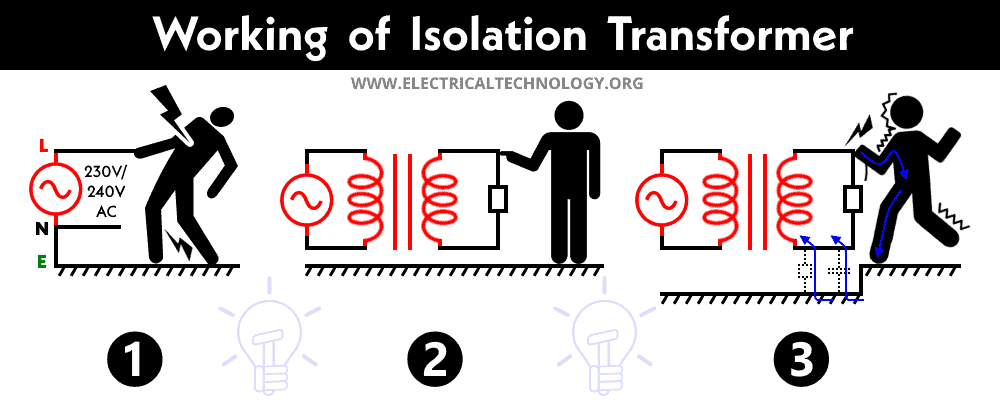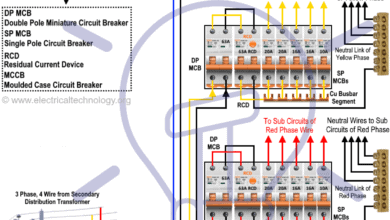What is an Isolation Transformer? – Its Construction, Working and Applications
Isolation Transformer – Construction, Working and Applications
What is an Isolation Transformer?
Transformers are electrical machines that are used to transfer one form of AC electrical energy to another form of AC electrical energy without changing frequency. An isolation transformer is a transformer that is used to transfer isolated AC electrical power to a device or equipment for safety, protection or to reduce the harmonics and transient voltage surges. It provides isolation between the powered device and power source based on the Galvanic isolation where there is no conductive path between the power source and powered device.
The isolation transformers are used for safety purpose and it is also used to reduce transient and harmonics. It provides galvanic isolation. It means there is no conductive path present between the source and load. Hence, it protects devices from electric shock and reduces electrical noise in sensitive devices.
It is also used to connect two circuits that do not allow physical connections. The insulating transformer can work as a step-up transformer or step-down transformer. Generally, an isolation transformer does not use to change the value of electrical quantities. Therefore, in most cases, the turn ratio of an isolation transformer is one. It means the number of turns in the primary winding is the same as the number of turns in secondary windings and it makes equal values of the primary and secondary voltage.
The isolation transformer does not allow to pass DC components from one circuit to another. But it allows passing AC components. Also, a specially designed isolation transformer blocks interference caused by ground loops. The isolation transformer is used to protect sensitive devices such as; computers, laboratory instruments, and medical devices.
Related Posts:
- Autotransformer – Its Types, Operation, Advantages and Applications
- Ideal Transformer? Circuit, Working & Phasor Diagram
Working of Isolation Transformer
An isolation transformer is nothing but a simple transformer having a 1:1 transformation ratio. The power source is connected with the primary winding and the load or circuit which needs to protect is connected with the secondary winding.
The isolation transformer is used to reduce the transient from the power source. In power sources, there are many reasons to generate spikes in supply like; lightning, switching, or sudden change in load. This spike increases the voltage level from a few volts to thousand volts. Generally, spikes in voltage waveform are for a very short time (~3 ns). If this spike reaches the load, it may damage the equipment. Hence, it is necessary to reduce the spike level.
For that, an isolation transformer is used between the device and the power source. Let us assume, there is a high voltage high current spike produces in the supply line. And this spike passes through the primary winding of the isolation transformer. Due to the effect of inductance, the primary winding does not allow a sudden change in current.
Due to spikes in a waveform, the current increases and it results in an increase in flux. And it increases voltage in the secondary. Due to the inductive nature of the transformer, it will oppose the spike from reproducing in secondary. The opposition to the current will be proportional to the speed at which it changes.
The spikes contain fast changes in voltage and current. Hence, the spike in the secondary circuit is greatly reduced avoiding undesirable effects on load equipment as shown in the waveform above.
How does Isolation Transformer work as Safety Device?
The isolation transformer is used as a safety device because it avoids direct connection between the power source and equipment. To understand the working principle, consider the figure below.
In the first picture, when the man touches the live terminal, a leakage current will flow through the body. And the man gets shocked.
In the second picture, an isolation transformer is connected to the power source. In this condition, if a man touches the secondary terminal of an isolation transformer, the man will not get shocked. Because the leakage current cannot be grounded by the human body as there is no path to flow.
In the third picture, the return path is shown as either capacitive or direct. If there is capacitive coupling, the man may feel a mild shock from the live conductor. Capacitive coupling is used when the appliance body is connected to a conductor. And there is no physical connection between body and ground.
Related Posts:
- Potential Transformer (PT)? Types & Working of Voltage Transformers
- Current Transformers (CT) – Types, Characteristic & Applications
Applications
The applications of isolation transformers are listed below.
- A small size isolation transformer is used for isolation in pulse circuits.
- An isolation transformer with a ratio of 1:1 is used under load conditions (as a power transformer) for safety purposes.
- Electrical isolation is necessary for medical equipment and some special standard equipment. In that case, an isolation transformer is connected with equipment.
- An isolation transformer is used to reduce harmonics and transient in electrical circuits.
- It is also used to provide electrical isolation between the power source and equipment.
- It is also used to safely troubleshoot and test electrical and electronics components without touching the live part of the circuit which protects from the electric shock and hazardous voltage,
Related Posts:
- Electrical Transformer – Construction, Working, Types and Applications
- Types of Transformers and Their Applications
- Applications of Transformers
- EMF Equation of a Transformer
- Transformer Losses – Different Types of Losses in a Transformer
- Parallel Operation of Single-Phase & Three-Phase Transformers
- Open Circuit and Short Circuit Test of a Transformer
- Sumpner’s Test or Back-To-Back Test on Transformer
- Scott-T Connection of Transformer
- Polarity Test of a Transformer – Circuit Diagram and Working
- Transformer Efficiency, All day Efficiency & Condition for Maximum Efficiency
- The Dot Convention and Dot Notation in a Transformer Phasing
- Transformer Performance & Electrical Parameters
- Power Transformer Protection and Faults
- Transformers Fire Protection System – Causes, Types & Requirements
- Cooling Methods of a Transformer
- Difference Between Single Phase and Three Phase Transformer
- Difference Between Power Transformers and Distribution Transformers?
- Advantages of a Three Phase Transformer over a Single Phase Transformer
- Electrical Transformer Symbols – Single Line Transformer Symbols
- Transformers (MCQs With Explanatory Answers)









I liked this article, I run a small appliance repair vintage radio and tv etc.